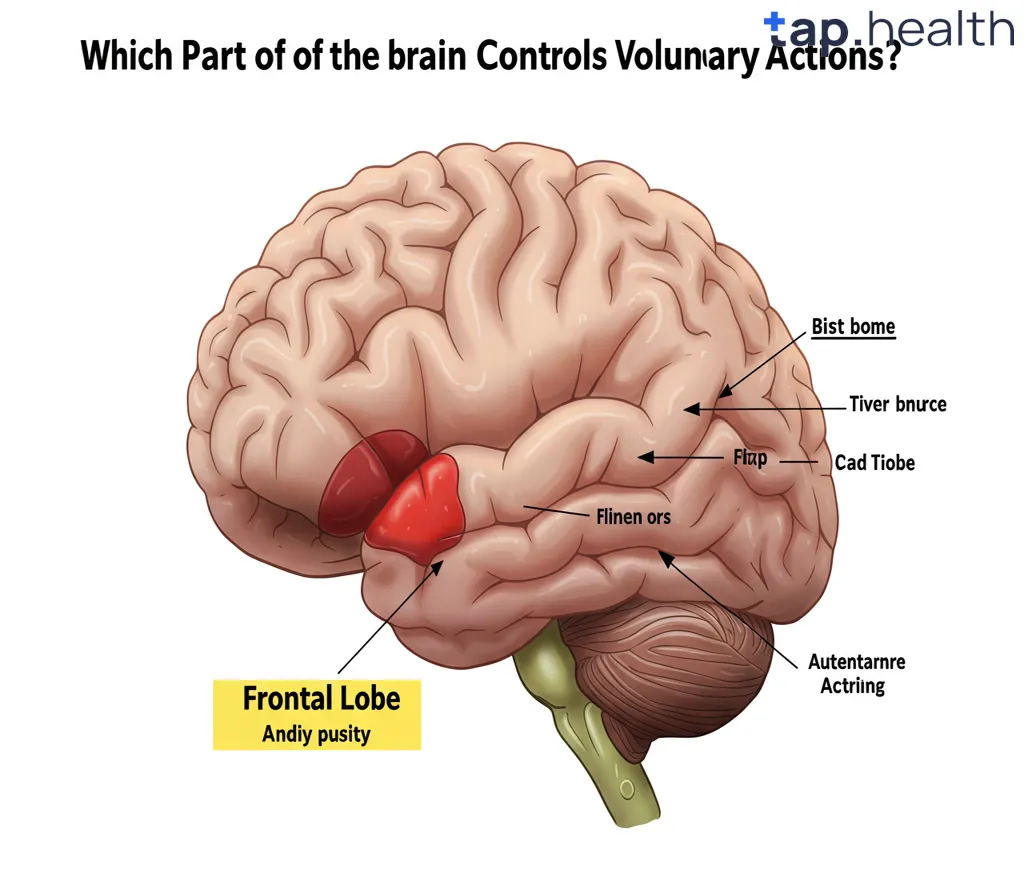ave you ever waved hello, kicked a soccer ball, or picked up a pencil to write your name?
These are all voluntary actions—things you choose to do on purpose.
But here’s a cool question: Which part of the brain controls these actions?
Spoiler: It’s not your whole brain. Just one special area is in charge.
The answer is the motor cortex, a strip of brain tissue that sits near the top of your head.
In this article, we’ll break down everything you need to know about the motor cortex:
- What it is
- How it tells your body to move
- What happens when it gets hurt
- Why it’s so important for everyday life
We’ll keep it simple, fun, and super easy to understand—like you’re learning from a friendly science teacher. No confusing jargon. No robot talk. Just real, clear facts anyone (even an 8th grader) can follow.
Let’s dive in.
What Are Voluntary Actions?
Before we talk about the brain, let’s understand what “voluntary actions” really mean.
1. Voluntary vs. Involuntary Actions
Your body does two kinds of things:
| Voluntary Actions | Things youchooseto do | Walking, writing, talking, waving, jumping |
| Involuntary Actions | Things that happenwithout thinking | Heart beating, breathing, digesting food |
So, when you decide to raise your hand in class—that’s voluntary.
But when your heart beats or your stomach growls—that’s involuntary.
The brain parts that control these are different.
Today, we’re focusing on voluntary actions—and the part of the brain that makes them possible.
2. Why Are Voluntary Actions Important?
Voluntary actions let you:
- Interact with the world (touch, grab, point)
- Express yourself (talk, smile, dance)
- Learn new skills (play piano, ride a bike)
- Stay independent (dress, eat, write)
Without the ability to control your movements, daily life would be extremely hard.
And it all starts in one key brain area: the motor cortex.
Which Part of the Brain Controls Voluntary Actions?
The short answer: the primary motor cortex.
But let’s go deeper.
1. Location of the Motor Cortex
The motor cortex is located in the front part of the brain, just behind your forehead.
More precisely:
- It sits in the parietal lobe, right in front of a deep groove called the central sulcus.
- It runs like a headband across the top of your brain, from ear to ear.
This area is part of the cerebrum, the largest part of the brain responsible for thinking, memory, and movement.
2. The Motor Cortex Is Not Alone
While the primary motor cortex gives the final “go” signal for movement, it doesn’t work alone.
It’s supported by other nearby brain areas:
| Premotor Cortex | Plans movements before you do them (e.g., deciding to pick up a cup) |
| Supplementary Motor Area (SMA) | Coordinates complex actions (like tying shoelaces with both hands) |
| Frontal Lobe | Involved in decision-making and starting voluntary actions |
Together, these areas form a movement control team, with the primary motor cortex as the team leader.
How Does the Motor Cortex Control Movement?
Think of the motor cortex as the command center for your muscles.
Here’s how it works—step by step.
1. You Decide to Move
Let’s say you want to wave your hand.
Your thought starts in the frontal lobe (“I want to wave”).
This message goes to the premotor cortex, which plans the movement.
Then, the primary motor cortex gets the signal: “Send command to arm muscles!”
2. Electrical Signal Travels Down the Spine
The motor cortex sends an electrical signal through nerves:
- Down the spinal cord
- Through motor neurons
- To the muscles in your arm and hand
This signal tells the muscles to contract (squeeze), making your hand move.
All of this happens in a split second.
3. Muscles Respond
When the signal reaches your arm muscles:
- The biceps and forearm muscles contract
- Your hand lifts and moves side to side
- You wave!
And just like that, your voluntary action is complete.
The Motor Homunculus: Your Brain’s Body Map
Here’s something wild: the motor cortex doesn’t treat all body parts equally.
Some areas of your body take up more space in the motor cortex than others.
Scientists call this the motor homunculus—a funny word that means “little man.”
It’s a map of your body drawn inside your brain.
H3: 1. What the Motor Homunculus Looks Like
Imagine a tiny, stretched-out person lying across the motor cortex:
- Face and hands take up a huge amount of space
- Legs and trunk take up less
Why? Because you use your fingers, lips, and tongue for very precise movements (like writing, speaking, eating).
So your brain gives them more “real estate.”
Example: Your thumb has a bigger spot in the motor cortex than your entire back!
2. Why This Matters
This explains why:
- You can write tiny letters with your fingers
- A pianist can play fast, complex songs
- Surgeons have such steady hands
Their motor cortex has been trained to control these small muscles with high precision.
What Happens If the Motor Cortex Is Damaged?
If the motor cortex gets injured, voluntary movements can be affected.
This often leads to a condition called paralysis or weakness on one side of the body.
Common Causes of Damage:
| Stroke | A blood clot or bleeding in the brain can damage the motor cortex, leading to weakness or paralysis (often on one side of the body) |
| Head Injury | A strong blow to the head can bruise or tear brain tissue |
| Brain Tumor | A growth can press on the motor cortex |
| Multiple Sclerosis (MS) | Damages nerve coverings, slowing signals from the brain to muscles |
| Cerebral Palsy | Caused by brain damage before or during birth, affecting movement and posture |
1. Symptoms of Motor Cortex Damage
- Weakness or paralysis in arms, legs, or face
- Difficulty writing or holding objects
- Slurred speech (if face muscles are affected)
- Trouble walking or balancing
- Slow or clumsy movements
These symptoms depend on which part of the motor cortex is damaged.
For example:
- Damage to the hand area → trouble gripping
- Damage to the face area → drooping mouth or trouble smiling
H3: 2. Can You Recover?
Yes—sometimes.
The brain has a special ability called neuroplasticity—its power to rewire itself.
After injury, other parts of the brain can sometimes take over the job of the damaged motor cortex.
This is why:
- Stroke survivors can regain movement with physical therapy
- Kids with cerebral palsy improve with exercise and training
- Patients learn to use their non-dominant hand
Recovery takes time, effort, and patience—but it’s possible.
Real-Life Example: Stroke and the Motor Cortex
Let’s look at a real-world example.
John’s Story
John, age 62, had a stroke. The blood flow to the left side of his brain was blocked—specifically in the right motor cortex.
After waking up:
- His left arm and leg were weak
- He couldn’t lift his arm or walk properly
- His speech was slurred
Why? Because the right motor cortex controls the left side of the body.
Doctors confirmed: damage to the motor cortex was the cause.
With months of physical and speech therapy, John slowly regained strength. His brain rewired itself, and other areas helped take over some of the movement control.
Today, he walks with a cane and writes slowly—but he’s independent.
This shows how crucial the motor cortex is—and how the brain can adapt when it’s hurt.
How Do Scientists Study the Motor Cortex?
Researchers use cool tools to understand how the motor cortex works.
1. fMRI (Functional MRI)
- Shows brain activity in real time.
- Lights up the motor cortex when you move your hand or foot.
- Helps doctors see which areas are active during tasks.
2. EEG (Electroencephalogram)
- Measures electrical activity in the brain.
- Can detect signals from the motor cortex before movement begins.
3. TMS (Transcranial Magnetic Stimulation)
- A magnet is placed near the scalp.
- It sends a small pulse to the motor cortex.
- Can cause a finger or toe to twitch—proving the area controls movement.
4. Animal Studies
- Scientists study monkeys and mice.
- They observe how brain signals lead to movement.
- This helps develop treatments for paralysis and brain injuries.
All of this research confirms: the motor cortex is the main controller of voluntary actions.
Can You Improve Your Motor Cortex?
Absolutely!
Just like muscles, your motor cortex gets stronger with practice.
1. Practice New Skills
- Learning to play guitar
- Typing faster
- Doing puzzles
These activities challenge your brain and improve motor control.
2. Physical Exercise
- Running, swimming, dancing
- Strength training
- Balance exercises
All of these send signals from the brain to muscles, keeping the motor cortex active.
3. Mind-Body Activities
- Yoga
- Tai chi
- Martial arts
These combine movement, focus, and coordination—great for brain health.
4. Use Your Non-Dominant Hand
Try brushing your teeth or writing with your left hand (if you’re right-handed). It forces your brain to work harder and build new connections.
Over time, your motor cortex becomes sharper and more efficient.
Is the Motor Cortex the Only Brain Area Involved in Movement?
Nope. It’s the main boss, but it has a team.
Supporting Brain Areas:
1. Basal Ganglia
- Helps start and stop movements smoothly.
- Problems here can cause Parkinson’s disease (tremors, slow movement).
2. Cerebellum
- Coordinates balance and fine-tunes movements.
- Makes sure your hand doesn’t overshoot when you reach for a cup.
3. Thalamus
- Acts like a relay station.
- Sends sensory info to the motor cortex so you can adjust your movements.
4. Spinal Cord
- Carries signals from the brain to muscles.
- Without it, the motor cortex’s commands wouldn’t reach the body.
So, while the motor cortex starts the action, the whole nervous system works together to make it happen.
Fun Facts About the Motor Cortex
Let’s make it fun!
- 🧠 The motor cortex is about the size of a bath towel—when spread out flat.
- ⚡ It sends signals at speeds up to 268 miles per hour!
- 🖐️ Your fingers have more motor cortex space than your legs.
- 🎹 Pianists have larger motor cortex areas for their fingers.
- 🤹 Jugglers grow more brain cells in the motor cortex after just a few weeks of practice.
- 🧒 Kids’ motor cortex develops as they learn to walk, talk, and write.
Common Misconceptions About the Motor Cortex
Let’s clear up some myths.
Myth 1: “The cerebellum controls voluntary actions.”
Truth: The cerebellum helps with balance and coordination, but the motor cortex starts the movement.
Myth 2: “The brain sends one signal for each muscle.”
Truth: The motor cortex sends signals to groups of muscles working together (like all the muscles in your hand when you grab something).
Myth 3: “Only the brain controls movement.”
Truth: The brain starts it, but nerves, spinal cord, and muscles must all work together.
Myth 4: “If the motor cortex is damaged, you can never move again.”
Truth: Many people recover through therapy, thanks to the brain’s ability to rewire itself.
How Does the Motor Cortex Develop in Children?
Kids aren’t born with full control over their movements.
Babies start with simple reflexes (like grabbing your finger), but over time, their motor cortex learns to control voluntary actions.
Milestones in Motor Cortex Development:
| 0–6 months | Lifting head, grasping |
| 6–12 months | Sitting, crawling, standing |
| 1–2 years | Walking, pointing, scribbling |
| 3–5 years | Running, jumping, using utensils |
| 6–12 years | Writing, tying shoes, riding a bike |
Each new skill strengthens the motor cortex.
That’s why play, movement, and practice are so important for kids—they’re literally building their brain.
How Does Aging Affect the Motor Cortex?
As we get older, the motor cortex can slow down.
This may lead to:
- Slower movements
- Weaker grip
- Poorer balance
- Difficulty with fine tasks (like buttoning a shirt)
But the good news? Exercise and mental activity can slow this down.
Studies show that older adults who stay active have better motor control and less risk of falls.
So, keep moving—your motor cortex will thank you!
The Motor Cortex and Technology
Scientists are now using knowledge of the motor cortex to create mind-controlled devices.
1. Brain-Computer Interfaces (BCIs)
- Devices that read brain signals from the motor cortex.
- Let paralyzed people control robotic arms or computer cursors just by thinking about moving.
Example: A person imagines moving their hand → the motor cortex fires → a sensor picks it up → a robot hand moves.
This tech is still growing, but it’s already changing lives.
2. Prosthetic Limbs
- Advanced artificial arms and legs respond to signals from the motor cortex.
- Users can grab, pinch, or walk more naturally.
All of this is possible because scientists understand which part of the brain controls voluntary actions.
Frequently Asked Questions (FAQ) on Which Part of the Brain Controls Voluntary Actions?
Q1: Which part of the brain controls voluntary actions?
Answer: The primary motor cortex, located in the frontal lobe near the top of the brain.
Q2: Where is the motor cortex located?
Answer: It’s in the parietal lobe, just in front of the central sulcus, running across the top of the brain from ear to ear.
Q3: What is the motor homunculus?
Answer: A map of the body in the motor cortex. It shows how much brain space each body part uses—hands and face take up the most.
Q4: Can the motor cortex repair itself?
Answer: It can’t grow new cells easily, but the brain can reorganize through neuroplasticity, allowing other areas to take over.
Q5: What happens if the motor cortex is damaged?
Answer: You may lose control over certain muscles, leading to weakness or paralysis on the opposite side of the body.
Q6: Does the left brain control the right side of the body?
Answer: Yes! The right motor cortex controls the left side of the body, and vice versa.
Q7: How does the brain tell muscles to move?
Answer: The motor cortex sends electrical signals through the spinal cord and nerves to the muscles, telling them to contract.
Q8: Is writing a voluntary action?
Answer: Yes! Writing is a voluntary action controlled by the motor cortex, especially the area for hand and finger movements.
Q9: Can you live without a motor cortex?
Answer: No—not normally. Severe damage can cause paralysis and loss of independence. Some function may remain, but voluntary control would be severely limited.
Q10: How can I keep my motor cortex healthy?
Answer:
- Exercise regularly
- Learn new physical skills
- Stay mentally active
- Eat brain-healthy foods (fish, nuts, veggies)
- Avoid head injuries (wear helmets)
Q11: What’s the difference between the motor cortex and cerebellum?
Answer: The motor cortex starts voluntary movements. The cerebellum fine-tunes them for balance and smoothness.
Q12: Why do I lose coordination when I’m tired?
Answer: Fatigue slows down brain signals. The motor cortex doesn’t send commands as quickly, so movements become clumsy.
Q13: Can emotions affect voluntary actions?
Answer: Yes. Stress or fear can make your hands shake or your voice tremble because they affect brain signals to muscles.
Q14: Do animals have a motor cortex?
Answer: Yes! All mammals have a motor cortex. In primates and humans, it’s especially advanced for complex movements.
Q15: How fast do motor cortex signals travel?
Answer: Up to 268 miles per hour (120 meters per second), depending on the nerve.
Final Thoughts
So, to answer the big question:
Which part of the brain controls voluntary actions?
The primary motor cortex.
It’s the brain’s movement command center—the part that lets you wave, write, run, and play.
Every time you move on purpose, your motor cortex is sending signals from your brain to your muscles, making it happen in seconds.
It’s not flashy. It doesn’t think or dream. But without it, you couldn’t do the things that make you you.
So next time you kick a ball, wave to a friend, or write your name—thank your motor cortex.
It’s working hard behind the scenes to keep you moving.



